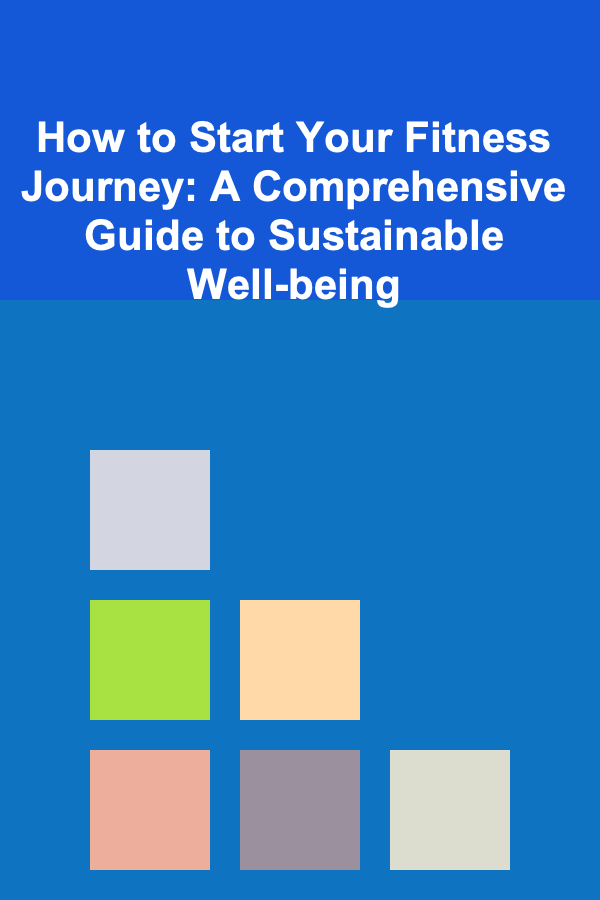
How to Start Your Fitness Journey: A Comprehensive Guide to Sustainable Well-being
ebook include PDF & Audio bundle (Micro Guide)
$12.99$10.99
Limited Time Offer! Order within the next:

Embarking on a fitness journey is one of the most profound and empowering decisions you can make for your overall well-being. It's a commitment to a healthier, more vibrant you, a promise to cultivate resilience, enhance vitality, and unlock a deeper connection with your body and mind. Yet, for many, the idea of "starting" can feel overwhelming, a colossal mountain to climb filled with daunting choices, confusing information, and the specter of past failed attempts.
This extensive guide is crafted to demystify the process, providing a deeply nuanced and practical roadmap for anyone ready to take that crucial first step -- and, more importantly, to sustain the momentum. We will delve far beyond the superficial advice of "just work out and eat healthy," exploring the psychological underpinnings, the physiological necessities, and the practical strategies that pave the way for a truly lifelong transformation. Fitness is not a destination; it is an evolving journey, and understanding how to initiate it wisely is the key to unlocking its enduring rewards.
The Pre-Flight Checklist: Laying the Foundation for Success
Before you even consider which workout routine to follow or what diet plan to adopt, a crucial preparatory phase is essential. This is where you build the mental and physical groundwork, ensuring your journey is built on solid, sustainable principles rather than fleeting motivation.
1. The Indispensable Medical Clearance: Consulting Your Physician
This is not merely a suggestion; it is a non-negotiable first step, especially if you have been sedentary for a long period, have pre-existing health conditions (such as heart disease, diabetes, asthma, or orthopedic issues), are over a certain age (e.g., 45 for men, 55 for women), or experience any unexplained symptoms. Your doctor can assess your current health status, identify any potential risks, and provide tailored recommendations or limitations. They might suggest specific types of exercise to avoid or prioritize, recommend dietary considerations, or even refer you to specialists if needed. Discuss your fitness aspirations openly, explaining the types of activities you're considering. This consultation transforms vague intentions into an informed, safe starting point.
2. Honest Self-Assessment: Where Are You Now?
Before charting your course, you must know your starting coordinates. This isn't about judgment; it's about objective reality. Consider various facets of your current health:
- Physical Condition: What is your current weight and body composition (if measurable)? What are your resting heart rate and blood pressure? How easily do you get winded? What are your current levels of strength, flexibility, and balance? Can you walk a certain distance comfortably? Do you have any chronic pain or mobility limitations?
- Energy Levels: Do you often feel fatigued? How is your sleep quality?
- Nutritional Habits: Be honest about your typical daily food choices. Are you consuming enough fruits, vegetables, lean proteins? How much processed food, sugar, or unhealthy fats do you consume? Are you adequately hydrated?
- Stress Levels: How do you manage stress? Stress significantly impacts hormones, recovery, and even body composition.
- Mental & Emotional State: How do you feel about yourself? Do you often feel lethargic or unmotivated? Fitness profoundly impacts mental health, and acknowledging your current state can highlight another powerful "why."
A helpful way to do this is to keep a short journal for a few days, noting your typical activities, food intake, and how you feel. This baseline provides tangible metrics for future progress, extending beyond just the scale.
3. The Mindset Reset: Cultivating Self-Compassion and Patience
This is arguably the most critical aspect of a sustainable fitness journey. Many individuals approach fitness with an "all-or-nothing" mentality, fueled by unrealistic expectations and self-criticism. This often leads to burnout, injury, and ultimate abandonment. Instead, cultivate:
- Self-Compassion: Recognize that perfection is unattainable. There will be good days and bad days, missed workouts, and less-than-ideal food choices. Treat yourself with the same kindness and understanding you would offer a friend. Learn from setbacks, don't dwell on them.
- Patience: Significant, lasting change takes time. The results you see on social media are often years in the making or highly edited. Focus on the process, not just the outcome. Celebrate small victories.
- Realistic Expectations: You won't transform your body overnight. Muscle gain is slow, fat loss is often non-linear. Understand that progress isn't always reflected on the scale.
- Intrinsic Motivation: While external motivators (like looking good for an event) can kickstart your journey, long-term adherence comes from intrinsic motivation -- the desire to feel good, to have more energy, to improve your health, to challenge yourself. Connect with your deepest "why."
- Process-Oriented Thinking: Shift your focus from outcome goals (e.g., "lose 20 pounds") to process goals (e.g., "walk 30 minutes daily," "prepare healthy meals four times a week"). Process goals are within your control and build consistent habits.
Phase 1: Crafting Your Personalized Blueprint
With a solid foundation in place, it's time to design a plan that is not just effective but also enjoyable and sustainable for your unique life.
1. Defining Your "Why" and Setting SMART Goals
Before you pick up a dumbbell or hit the trail, ask yourself: Why am I doing this? Your "why" should be deeply personal and resonate with your values. Is it to play with your kids without getting tired? To improve your mental clarity? To prevent chronic disease? To feel stronger and more confident? Once your "why" is clear, you can set effective goals.
Goals should be SMART:
- Specific: Instead of "get fit," aim for "walk 30 minutes three times a week" or "do 10 push-ups."
- Measurable: How will you track progress? (e.g., time, distance, weight lifted, number of repetitions, energy levels).
- Achievable: Set realistic goals that challenge you but don't overwhelm you. Start small and build up.
- Relevant: Your goals should align with your "why" and your overall life aspirations.
- Time-bound: Set a deadline (e.g., "by the end of three months," "by next quarter").
Combine short-term process goals (e.g., "complete 3 strength workouts this week") with longer-term outcome goals (e.g., "be able to run a 5k in six months"). The former builds habits, the latter provides direction.
2. Exploring Exercise Modalities: Finding Your Fit
Fitness is not a one-size-fits-all endeavor. The best exercise is the one you will consistently do. Experimentation is key to finding activities you genuinely enjoy. A balanced fitness plan typically incorporates elements of:
A. Cardiovascular (Aerobic) Exercise
This strengthens your heart and lungs, improves endurance, and helps with fat loss. Aim for at least 150 minutes of moderate-intensity or 75 minutes of vigorous-intensity cardio per week.
- Walking/Hiking: Accessible, low-impact, great for beginners. Can be done anywhere.
- Running/Jogging: More intense, good for building endurance and burning calories. Start with walk/run intervals.
- Cycling: Low-impact, good for joints. Can be done outdoors or on a stationary bike.
- Swimming: Full-body, low-impact, excellent for overall fitness and joint health.
- Dancing: Fun, expressive, and a great way to elevate your heart rate.
- Group Fitness Classes: Zumba, aerobics, step, spinning -- offer motivation and instruction.
- Team Sports: Basketball, soccer, tennis -- combine fitness with social interaction.
Tip for Beginners: The "Talk Test"
For moderate intensity, you should be able to hold a conversation, but not sing. For vigorous intensity, you should only be able to speak a few words at a time.
B. Strength (Resistance) Training
Crucial for building muscle mass, increasing metabolism, strengthening bones, and improving functional strength for daily activities. Don't skip this, regardless of gender or age. Aim for 2-3 sessions per week, targeting all major muscle groups.
- Bodyweight Exercises: Push-ups (modified), squats, lunges, planks, glute bridges. Excellent for home workouts and mastering basic movement patterns.
- Free Weights: Dumbbells, barbells, kettlebells. Offer versatility and allow for progressive overload.
- Resistance Bands: Portable, versatile, provide constant tension.
- Machine Weights: Good for beginners as they guide movement, but limit stabilization muscles.
- Yoga/Pilates: Combine strength, flexibility, and core stability using bodyweight.
Focus on compound movements (e.g., squats, deadlifts, presses, rows) that work multiple muscle groups simultaneously. Start with lighter weights or fewer repetitions to master form before increasing the load.
C. Flexibility and Balance Training
Often overlooked but vital for injury prevention, improved range of motion, and maintaining functional independence as you age.
- Stretching: Static (holding a stretch) and dynamic (moving through a range of motion). Incorporate both pre and post-workout.
- Yoga/Pilates: Excellent for improving both flexibility and core strength, which is fundamental for balance.
- Tai Chi: Low-impact, mindful movements that significantly enhance balance and proprioception.
- Balance Exercises: Standing on one leg, heel-to-toe walk, using a wobble board.
3. Nutrition: Fueling Your Machine, Not Depriving It
Exercise accounts for only a fraction of your fitness success; nutrition is the cornerstone. This isn't about restrictive diets that are impossible to maintain, but rather about cultivating sustainable, healthy eating habits.
- Prioritize Whole Foods: Focus on unprocessed or minimally processed foods: fruits, vegetables, lean proteins (chicken, fish, beans, lentils, tofu), whole grains (oats, brown rice, quinoa), and healthy fats (avocado, nuts, seeds, olive oil).
- Understand Macronutrients:
- Protein: Essential for muscle repair and growth, satiety. Include a source at every meal.
- Carbohydrates: Your body's primary energy source. Choose complex carbs for sustained energy.
- Fats: Vital for hormone production, nutrient absorption. Choose unsaturated fats.
- Hydration is Key: Drink plenty of water throughout the day. Dehydration can impair performance, metabolism, and overall well-being. Aim for at least 2-3 liters daily, more if exercising intensely.
- Mindful Eating: Pay attention to your body's hunger and fullness cues. Eat slowly, savor your food, and avoid distractions. This helps prevent overeating.
- Portion Control: While focusing on whole foods, be mindful of portion sizes, especially if your goal is weight management.
- Limit Processed Foods, Added Sugars, and Unhealthy Fats: These offer little nutritional value and can contribute to inflammation and weight gain.
- Meal Preparation (Meal Prep): Planning and preparing healthy meals in advance can save time, reduce stress, and prevent unhealthy impulse eating.
- Don't Demonize Foods: A balanced approach allows for occasional treats without guilt. Consistency over perfection is the mantra.
4. Setting Up Your Environment for Success
Your surroundings can significantly impact your ability to stick to your fitness goals.
- Home Environment:
- Kitchen: Stock your pantry and fridge with healthy ingredients. Remove tempting processed foods. Invest in basic cooking tools.
- Workout Space: Designate a small area for exercise, even if it's just enough room for a yoga mat. Having small equipment like resistance bands or light dumbbells visible can be a great cue.
- Workout Location:
- Gym: If you join a gym, choose one that's convenient, clean, and has the equipment you need. Consider a trial membership. Don't be intimidated; everyone started somewhere.
- Outdoors: Parks, trails, local tracks. Nature can be a powerful motivator.
- Home Workouts: Leverage online resources -- YouTube channels, fitness apps, virtual classes.
- Essential Gear:
- Footwear: Invest in appropriate shoes for your chosen activity (running shoes, cross-trainers).
- Comfortable Clothing: Moisture-wicking fabrics are ideal.
- Water Bottle: Keep hydration easily accessible.
- Basic Equipment: A yoga mat, resistance bands, a jump rope, or a pair of light dumbbells can kickstart home workouts.
5. Time Management and Consistency
Lack of time is a common barrier. The key is to make fitness a non-negotiable appointment.
- Schedule Your Workouts: Treat them like important meetings. Block out specific times in your calendar.
- Start Small: Even 15-20 minutes of activity is better than nothing. Build up gradually.
- Find Your Best Time: Are you a morning person? Lunchtime exerciser? Evening wind-down? Experiment to see when you're most likely to stick with it.
- Integrate Movement: Look for opportunities to move more throughout your day: take stairs, park further away, walk during phone calls, stretch during breaks.
- Consistency Over Intensity: Showing up regularly for moderate workouts is far more effective than sporadic, grueling sessions followed by long breaks.
Phase 2: The First Steps & Beyond -- Action and Adaptation
With your blueprint in hand, it's time to put theory into practice. This phase focuses on the execution of your plan, learning to listen to your body, and tracking your progress.
1. Start Slow, Progress Smart: The Principle of Progressive Overload
This is paramount for injury prevention and long-term adherence. Do not attempt too much, too soon. Your body needs time to adapt. Start with a manageable intensity and volume, and gradually increase it over time.
- Beginner Cardio: If starting with walking, begin with 20 minutes at a comfortable pace, 3-4 times a week. After a couple of weeks, increase duration by 5-10 minutes, or gradually pick up the pace.
- Beginner Strength: Focus on mastering proper form with light or no weight. Perform 2-3 sets of 8-12 repetitions. Once you can comfortably complete all reps with good form, then consider increasing the weight or adding more reps/sets. This is "progressive overload" -- continually challenging your body just a little bit more than it's accustomed to.
- Listen to Your Body: Acknowledge that some muscle soreness (DOMS - Delayed Onset Muscle Soreness) is normal, especially when starting new activities. However, sharp pain is a warning sign; stop immediately if you feel it.
2. Mastering Proper Form: Your Injury Prevention Shield
Incorrect form is the leading cause of exercise-related injuries. Before adding weight or increasing intensity, ensure your technique is flawless. This often means sacrificing ego for safety and effectiveness.
- Utilize Resources: Watch instructional videos from reputable sources (e.g., certified trainers, sports physiologists).
- Consider Professional Guidance: Even a few sessions with a certified personal trainer can be invaluable. They can assess your movement patterns, correct your form, and provide a personalized program tailored to your body's mechanics.
- Mirror Check: If working out at home, use a mirror to observe your form.
- Focus on Mind-Muscle Connection: Consciously think about the muscles you're working. Feel them contract and extend.
3. The Crucial Role of Recovery: Rest, Sleep, and Stress Management
Muscles don't grow in the gym; they grow during recovery. Neglecting recovery is a common mistake that leads to burnout, injury, and stalled progress.
- Rest Days: Schedule dedicated rest days into your week. These allow your muscles to repair and rebuild, and your nervous system to recover. Active recovery (light walks, stretching, foam rolling) can be beneficial on rest days.
- Sleep: This is non-negotiable for physical and mental recovery. Aim for 7-9 hours of quality sleep per night. During deep sleep, growth hormone is released, aiding muscle repair. Sleep deprivation impairs performance, recovery, and decision-making (including food choices). Create a consistent sleep schedule and optimize your sleep environment.
- Stress Management: Chronic stress elevates cortisol, which can hinder fat loss, promote muscle breakdown, and disrupt sleep. Incorporate stress-reducing activities like meditation, deep breathing, spending time in nature, or engaging in hobbies.
- Stretching and Mobility Work: Regular stretching improves flexibility and range of motion, reducing stiffness and risk of injury. Foam rolling can help release muscle knots and improve blood flow.
4. Tracking Your Progress: Beyond the Scale
The scale can be a useful tool, but it tells only a fraction of the story. Weight fluctuates due to water retention, muscle gain (which is denser than fat), and other factors. Relying solely on the scale can be demotivating.
Consider a multi-faceted approach to tracking:
- Performance Metrics:
- Strength: Increased weight lifted, more repetitions, better form.
- Cardio: Faster pace, longer duration, lower perceived exertion for the same activity.
- Mobility: Increased range of motion in specific joints.
- Body Measurements: Use a tape measure to track changes in waist, hips, thighs, arms every 4-6 weeks. These often reflect fat loss even if the scale doesn't budge.
- Progress Photos: Take photos every 4-8 weeks from the front, side, and back. Visual changes can be incredibly motivating.
- Non-Scale Victories (NSVs): These are powerful indicators of progress:
- More energy throughout the day.
- Better sleep quality.
- Clothes fitting better.
- Improved mood and reduced anxiety.
- Increased stamina for daily tasks (e.g., climbing stairs, carrying groceries).
- Reduced aches and pains.
- Improved digestion.
- Feeling stronger and more confident.
- Fitness Journal: Record your workouts (exercises, sets, reps, weight, duration, intensity), food intake, sleep, mood, and any NSVs. This provides objective data and helps you identify patterns.
5. Navigating Nutrition in Real Life: Practical Strategies
Eating healthy isn't just about knowing what to eat; it's about integrating it into your daily life.
- Batch Cooking/Meal Prep: Dedicate a few hours one day a week to prepare ingredients or entire meals. Cook a large batch of grains, roast vegetables, cook lean protein. This ensures healthy options are always available.
- Smart Snacking: Have healthy snacks readily available to prevent cravings for unhealthy options (e.g., fruit, nuts, Greek yogurt, vegetable sticks with hummus).
- Eating Out Strategies: Look up menus online in advance. Choose grilled or baked options, ask for sauces on the side, load up on vegetables, and be mindful of portion sizes. Don't be afraid to ask for modifications.
- Dealing with Cravings: Understand the difference between true hunger and emotional cravings. Distraction, drinking water, or having a healthy alternative can help. Sometimes, a small portion of what you crave is better than feeling deprived.
- Understanding Food Labels: Learn to read nutrition labels to identify added sugars, unhealthy fats, and sodium content. Focus on whole ingredients.
- Don't Be Afraid to Adapt: If a meal plan feels too restrictive or complicated, simplify it. Find healthy swaps for your favorite comfort foods.
Phase 3: Sustaining Momentum and Embracing Evolution
The initial burst of motivation often wanes. True success lies in building habits and strategies to navigate the inevitable challenges of a lifelong fitness journey.
1. Building Unshakable Habits: The Power of Consistency
Motivation is fleeting; habits are what endure. Habit formation involves a cue, a routine, and a reward.
- Identify Your Cues: What triggers your desired behavior? (e.g., waking up, finishing work, seeing your gym bag).
- Create a Routine: Make the desired action easy and automatic. (e.g., lay out workout clothes the night before, schedule workouts at the same time each day).
- Establish Rewards: Immediately after completing the habit, give yourself a reward (non-food related). This strengthens the neural pathway. (e.g., listening to your favorite podcast, a relaxing shower, feeling accomplished).
- Stack Habits: Pair a new habit with an existing one (e.g., "After I brush my teeth, I will do 10 squats").
- Environmental Cues: Keep your running shoes by the door, healthy snacks visible.
- Accountability: Tell a friend your goals, find a workout buddy, or work with a coach. External accountability can be a powerful motivator in the early stages.
"We are what we repeatedly do. Excellence, then, is not an act, but a habit." - Aristotle
2. Overcoming Plateaus: Strategies for Continued Progress
At some point, your progress will slow or stop. This is normal; your body adapts. Plateaus are not failures; they are opportunities to adjust your strategy.
- Vary Your Routine: Change exercises, increase reps, sets, or weight. Try a different type of cardio. Introduce new movements.
- Increase Intensity or Duration: If you've been doing moderate cardio, try interval training. If your strength workouts are easy, increase the weight or decrease rest times.
- Re-evaluate Nutrition: Are you consistently fueling your body properly? Are your calorie and macronutrient intakes still aligned with your goals? Are you hydrated?
- Prioritize Recovery: Are you getting enough sleep? Managing stress effectively? Sometimes, a deload week (reducing intensity/volume) can help your body recover and break through a plateau.
- Cross-Training: Incorporate activities that work different muscle groups or energy systems. This can prevent overuse injuries and keep things fresh.
- Seek Expert Advice: A personal trainer or nutritionist can help identify specific issues and suggest tailored adjustments.
3. Bouncing Back from Setbacks: Resilience and Self-Forgiveness
Life happens. You will miss workouts, have indulgent meals, or lose motivation. This is not a reason to abandon your journey. The difference between those who succeed and those who don't is how they respond to setbacks.
- Avoid All-or-Nothing Thinking: One missed workout or unhealthy meal does not derail your entire journey. It's a single data point, not a trend.
- Practice Self-Compassion: Don't beat yourself up. Acknowledge the setback, understand why it happened (if possible), and commit to getting back on track.
- Re-evaluate and Adjust: If setbacks are frequent, something might be wrong with your plan. Is it too ambitious? Not enjoyable enough? Does it fit your lifestyle? Adjust, don't quit.
- Focus on the Next Action: Don't dwell on the past. What is the very next healthy choice you can make? A glass of water? A short walk?
4. The Power of Community and Support Systems
You don't have to do this alone. Human connection can be a powerful motivator.
- Workout Buddy: Find a friend, family member, or colleague with similar goals. You can motivate each other, share experiences, and hold each other accountable.
- Group Fitness Classes: Provide a structured environment, expert instruction, and a sense of camaraderie.
- Online Communities: Join forums, social media groups, or apps dedicated to fitness. Share your journey, ask questions, and draw inspiration from others.
- Certified Professionals: Personal trainers, registered dietitians, or health coaches can provide personalized guidance, expertise, and accountability. This is an investment in your health.
5. Embracing Variety and Fun: Keeping the Journey Exciting
Monotony is the enemy of adherence. Your fitness journey should evolve with you and remain enjoyable.
- Try New Activities: Always wanted to try rock climbing, martial arts, or paddleboarding? Give it a go! Novelty keeps things fresh and engages different muscles.
- Set New Challenges: Sign up for a fun run, a charity walk, a hiking trip, or learn a new skill (e.g., handstand, pull-up).
- Explore Different Environments: Take your workout outdoors. Visit new trails or parks. Change gyms if yours feels stale.
- Gamify Your Fitness: Use fitness trackers with challenges, apps that turn workouts into games, or friendly competitions with friends.
- Connect with Nature: Spending time outdoors while exercising has added mental health benefits.
6. The Mental Game: Mindfulness and Stress Reduction
Fitness is as much about mental strength as it is about physical prowess.
- Mindful Movement: Pay attention to how your body feels during exercise. Focus on your breath, the contraction of your muscles. This enhances the experience and helps prevent injury.
- Stress Reduction: Chronic stress impacts hormones, making fat loss difficult and increasing cravings. Exercise is a natural stress reliever, but consider adding practices like meditation, deep breathing exercises, or journaling to your routine.
- Celebrate Non-Scale Victories: Regularly acknowledge and celebrate all the positive changes, big and small, that aren't reflected on the scale. This reinforces positive habits and boosts motivation.
- Body Positivity: Shift your focus from external appearance to what your body can do and how it feels. Cultivate a sense of gratitude for your body.
Conclusion: A Lifelong Journey of Growth and Discovery
Starting your fitness journey is not about achieving a temporary aesthetic goal; it is about cultivating a sustainable lifestyle that prioritizes your health, vitality, and overall well-being. It is a journey of self-discovery, resilience, and continuous growth. There will be triumphs and challenges, moments of peak motivation and periods of waning enthusiasm. The key is to embrace the process, learn from every experience, and remain adaptable.
Remember that fitness is holistic. It encompasses not just physical activity and nutrition, but also mental well-being, adequate rest, and a supportive environment. By focusing on sustainable habits, listening to your body, celebrating non-scale victories, and cultivating a mindset of patience and self-compassion, you lay the groundwork for enduring success.
This is your journey. It will be unique, evolving with you through different life stages and circumstances. Begin today, start small, and commit to the ongoing process of becoming the healthiest, strongest, and most vibrant version of yourself. The rewards---increased energy, improved mood, reduced risk of disease, enhanced confidence, and a deeper appreciation for your body's capabilities---are immeasurable and profoundly worth the effort.
Take that first step. The path unfolds with each stride. © 2023. All rights reserved.

How To Analyze the Evolution of a Director's Style
Read More
How to Fit More Items in Your Pantry Using Space-Saving Tips
Read More
How to Host a Family Talent Show at Home
Read More
How to Stage Your Home for Millennial Buyers
Read More
How To Pick the Perfect Action-Adventure Novel
Read More
Understanding Plot Twists: A Deep Dive
Read MoreOther Products

How To Analyze the Evolution of a Director's Style
Read More
How to Fit More Items in Your Pantry Using Space-Saving Tips
Read More
How to Host a Family Talent Show at Home
Read More
How to Stage Your Home for Millennial Buyers
Read More
How To Pick the Perfect Action-Adventure Novel
Read More